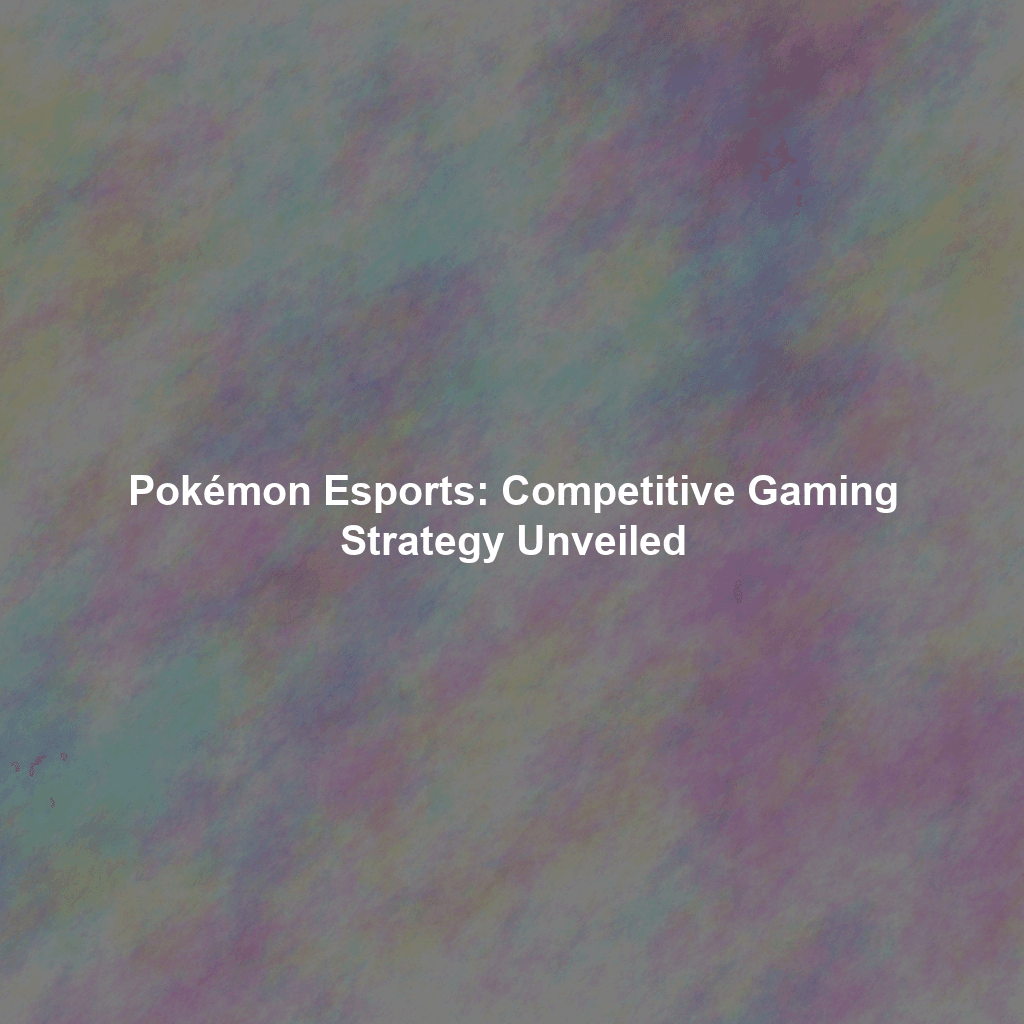Introduction: From Catching Them All to Conquering the Competitive Scene
Pokémon, a global phenomenon that has captivated audiences for over two decades, has successfully transitioned from a beloved childhood pastime to a thriving competitive scene. This article examines how The Pokémon Company International (TPCI) has strategically entered the esports market, leveraging its diverse game portfolio and dedicated fanbase to create a robust and engaging competitive ecosystem. We’ll dissect their approach to structuring competitive programs, cultivating a vibrant community of professional players, and using esports as a powerful marketing tool to enhance brand awareness and drive engagement. As part of the “Beyond Ash & Pikachu” series, this piece will shed light on another facet of Pokémon’s masterful marketing machine.
The Pokémon Company’s Esports Strategy: A Multi-Game Approach
Unlike many esports organizations that focus on a single title, TPCI has wisely chosen to embrace a multi-game approach, capitalizing on the diversity of the Pokémon franchise. This strategy allows them to appeal to a wider audience and create multiple avenues for competitive engagement.
Pokémon Video Game Championships (VGC): The Core of Competitive Pokémon
The Pokémon Video Game Championships (VGC) is the most established and recognizable part of the Pokémon esports landscape. Players compete in double battles using the latest mainline Pokémon games. TPCI sets the rules, formats, and restrictions to ensure a balanced and strategic playing field. VGC events range from local tournaments to regional championships, culminating in the prestigious World Championships. The structure, with its tiered progression, mimics traditional sports leagues and provides a clear path for aspiring professional players.
Example: The annual VGC World Championships draw thousands of players and spectators, with millions more watching online. The event showcases the highest level of Pokémon battling skill and strategy, significantly boosting the visibility of the latest Pokémon games.
Pokémon Trading Card Game (TCG): Strategic Card Battles Brought to Life
The Pokémon Trading Card Game (TCG) is another cornerstone of Pokémon esports. The TCG Championships, like VGC, follow a structured format, with players competing in local, regional, and international tournaments. The strategic depth of deck building and skillful card play makes the TCG a captivating esport for both participants and viewers. The meta evolves constantly with new card releases, keeping the game fresh and engaging.
Example: High-profile TCG tournaments often feature live commentary, analysis, and replays, mirroring the presentation of traditional sports broadcasts. These broadcasts help to educate new players and showcase the intricacies of the game.
Pokémon UNITE: Mobile MOBA Action
Pokémon UNITE, a free-to-play MOBA (Multiplayer Online Battle Arena) available on Nintendo Switch and mobile devices, represents Pokémon’s entry into the mainstream esports arena. Its accessibility and fast-paced gameplay make it appealing to a broader audience. TPCI has invested heavily in Pokémon UNITE esports, establishing regional leagues and a World Championship series. Its design specifically caters to a broader audience more aligned with general esports viewers.
Example: The Pokémon UNITE World Championships have attracted significant viewership, highlighting the game’s potential as a major esports title. TPCI’s marketing efforts around UNITE esports are focused on attracting new players to the game and showcasing its competitive depth.
Pokémon GO: A Unique Competitive Landscape
While not a traditional esport in the same vein as VGC or UNITE, Pokémon GO has carved out its own unique competitive niche. Community-organized Player vs. Player (PvP) tournaments, sanctioned by Niantic (the game’s developer) and supported by TPCI, have gained popularity. The GO Battle League, an in-game PvP system, also offers a competitive outlet for players. The emphasis on real-world exploration and social interaction distinguishes Pokémon GO esports from other titles.
Example: Community-run Pokémon GO tournaments often involve real-world meetups and organized battles in parks and public spaces, fostering a sense of community and promoting physical activity.
Cultivating a Community of Professional Players
A thriving esports scene relies on a dedicated community of professional players. TPCI has implemented several strategies to nurture and support its competitive player base.
Championship Points and World Championships Qualification
The Championship Point system provides a clear and transparent pathway for players to qualify for the World Championships. Players earn points by performing well in officially sanctioned tournaments throughout the season. This system incentivizes participation and rewards consistent performance, fostering a competitive environment and providing a tangible goal for aspiring professionals.
Scholarships and Prizes
TPCI offers scholarships and prize money to top-performing players in various esports disciplines. These financial incentives help to support professional players and encourage them to dedicate their time and effort to competitive Pokémon. The increasing prize pools over the years signify TPCI’s commitment to growing the esports scene.
Community Building and Engagement
TPCI actively engages with the Pokémon esports community through social media, online forums, and live events. They provide platforms for players to connect, share strategies, and build relationships. This fosters a sense of belonging and encourages players to support each other. Community managers actively solicit feedback and address concerns from the player base, ensuring that the competitive scene remains vibrant and healthy.
Leveraging Esports for Marketing and Brand Awareness
Esports serves as a powerful marketing tool for TPCI, extending the reach of the Pokémon brand and engaging new audiences. Here’s how:
Showcasing New Games and Features
Esports tournaments provide a platform to showcase the latest Pokémon games and features. Viewers get to see the games in action at the highest level of play, which can generate excitement and drive sales. New gameplay mechanics, Pokémon, and strategies are revealed during these events, piquing the interest of both competitive and casual players.
Reaching a Younger Audience
Esports is particularly effective at reaching a younger audience, which is a key demographic for the Pokémon franchise. By investing in esports, TPCI can connect with this audience on their own terms and build brand loyalty. The inherent digital-first nature of esports aligns perfectly with the digitally savvy younger generation.
Content Creation and Distribution
Esports generates a wealth of content that can be distributed across various platforms, including YouTube, Twitch, and social media. Tournament highlights, player interviews, and strategy guides provide engaging content for Pokémon fans and help to promote the brand. This content also contributes to the discoverability of Pokémon and its games through search engines.
Sponsorship Opportunities
Pokémon esports events attract sponsorships from various brands, providing TPCI with additional revenue streams and marketing opportunities. These sponsorships further enhance the visibility of the Pokémon brand and demonstrate its appeal to a wider audience. Aligning with complementary brands (e.g., energy drinks, gaming hardware) allows for cross-promotional opportunities and expanded reach.
Challenges and Future Directions for Pokémon Esports
While Pokémon has made significant strides in the esports arena, several challenges remain.
Maintaining Game Balance and Meta Diversity
Ensuring game balance and a diverse meta is crucial for maintaining the long-term health of Pokémon esports. TPCI needs to continuously monitor the competitive scene and make adjustments to prevent any single strategy or Pokémon from dominating the meta. Regular updates and balance patches are essential for keeping the gameplay fresh and engaging.
Addressing Regional Disparities
Access to resources and opportunities for competitive Pokémon can vary significantly across different regions. TPCI needs to address these disparities by providing more support for emerging regions and ensuring that all players have a fair chance to compete at the highest level. Targeted initiatives, such as regional training camps and online tournaments, can help to level the playing field.
Expanding Viewership and Accessibility
While Pokémon esports has a dedicated following, there is still room to expand viewership and accessibility. TPCI can achieve this by improving the production quality of broadcasts, providing more educational content for new players, and making the competitive scene more welcoming to casual fans. Simplified commentary, on-screen graphics explaining complex strategies, and interactive elements (e.g., polls, quizzes) can enhance the viewing experience.
The Future of Pokémon Esports
The future of Pokémon esports looks bright. With continued investment and innovation, TPCI can solidify its position as a major player in the competitive gaming market. Exploring new game formats, integrating augmented reality (AR) elements, and partnering with other esports organizations are just a few of the potential avenues for growth. The continued success of Pokémon UNITE and the evolution of Pokémon GO esports will be key indicators of the franchise’s long-term commitment to the competitive scene.
Conclusion: A Masterclass in Brand Extension and Community Engagement
Pokémon’s foray into esports exemplifies a successful brand extension strategy. By leveraging its established brand, diverse game portfolio, and dedicated fanbase, TPCI has created a thriving competitive ecosystem that enhances brand awareness, engages new audiences, and drives revenue. The multi-game approach, coupled with a focus on community building and player support, has been instrumental in Pokémon’s esports success. The Pokémon Company’s dedication to fostering a competitive environment, while remaining true to the core values of the franchise, underscores the power of strategic marketing within the “Beyond Ash & Pikachu” framework. As the esports industry continues to evolve, Pokémon is well-positioned to remain a dominant force in the competitive gaming market.
 Skip to content
Skip to content

